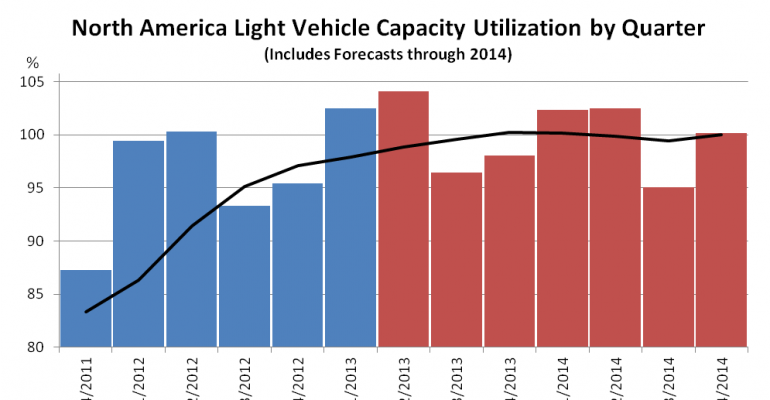Capacity utilization for North American light-vehicle production in 2013’s first three months equaled 102.5%, just over three percentage points above year-ago and the highest for any quarter since WardsAuto started tracking the data in 2005.
LV capacity utilization, measured by actual output as a percentage of the straight-time production each plant can build on a regular 2-shift schedule, is forecast in the second quarter to finish even higher at 104.1%.
Utilization will undergo a seasonal decline to 96.4% in the third quarter when manufacturers schedule vacation and most model-changeover downtime, then rebound slightly to 98.0% in 2013’s final three months, also a period when seasonal factors tend to mute results.
However, capacity utilization on a 12-month moving average, which smooths out seasonal variations, will continue to rise throughout the year.
The 12-month average ended March at 97.9%, up from 97.1% at the end of 2012, and from March 2012’s 95.1%. The rolling 12-month average will hit 100% by the end of 2013.
The strong results were bolstered by auto makers with a high mix of their plants working on 3-shift or 3-crew schedules, which lifts available production at those plants well above their 2-shift capacity.
Ford and Nissan, which are among the top six auto makers in North America, are the two biggest reasons industry capacity is running at 100% or more. But they are getting a lot of help from several manufacturers with only one or two facilities, nearly all of them on 3-shift/crew schedules.
Ford, including Flat Rock Assembly – still officially a joint venture with Mazda, though it now only assembles Ford products – had first-quarter utilization of 120.2%. Six of its 13 assembly plants are running on 3-crew/shift slates. Its 12-month average at the end of March was 109.5%, and will rise for the rest of the year, despite one plant, Kansas City 1, closed for entire 2013 for changeover to Ford’s new fullsize van.
Ford’s increases result from both rising demand and the change from a 2-shift schedule to a 3-crew operation in the third quarter at its Kansas City 2 plant, which builds Ford F-150 pickups. The move will add roughly 50,000 units annually to its available production of the trucks.
Nissan, which has three of its four plants on three shifts, had first-quarter utilization of 123.6%, and its 12-month moving total will rise to 125% by the end of the year from 113.0% through March.
Much of Nissan’s forecasted growth is through the addition of new products or first-time North American sourcing of models now imported from overseas. Recently it added production of Nissan Leaf electric vehicles at Smyrna, TN; NV200 small cargo vans at Cuernavaca, Mexico; and Note small multipurpose vehicles at Aguascalientes, Mexico.
In October, production of the Rogue cross/utility vehicle begins in North America for the first time at Smyrna (though it will be dual-sourced from Asia for the North American market).
Other auto makers that will experience rising utilization rates for the remainder of 2013 include BMW, Chrysler, Daimler, Hyundai, Kia, Mitsubishi, Subaru and Toyota. All except Mitsubishi and Subaru use 3-crew/shift operations.
The lone North American plants for BMW, Hyundai and Kia each run three shifts, and each is operating at well over 100% capacity utilization.
Chrysler has three plants on 3-crew/shift schedules, including the Dodge City plant in Warren, MI, which added a third crew last month to build Ram pickups. However, Chrysler’s first-quarter rate of 94.3% was one of the lowest among all auto makers due largely to its Toledo North plant being offline since August 2012 for changeover to the new Jeep Cherokee that launches production this month.
Chrysler’s 12-month moving rate will rise from 95.5% through March to 96.8% at the end of the year.
Volkswagen, which has been running well above 100% capacity since 2005, will see a decline in its 12-month average at year’s end. Its plant in Chattanooga, TN, which added a third crew at the end of last year to build Passat midsize sedans, is scaling back to two shifts over the next two months.
VW’s 12-month pace will drop to 130.8% by December from 148.1% in March.
General Motors, the largest North American manufacturer, will maintain relatively steady utilization for the rest of 2013.
Part of GM’s flat performance will be due to slowdowns at two of three plants building Chevrolet Silverado and GMC Sierra pickups for re-tooling to upgraded versions. GM also saw production slowdowns at some car plants due to bloated inventory.
GM’s first-quarter rate was 87.3%. Its 12-month average through March was 84.7%, solid results by historical standards, but somewhat pale compared with data coming from its competitors.
Meantime, including medium- and heavy-duty trucks, capacity utilization was 101.0% in first-quarter 2013, up from 98.8% year-ago.




